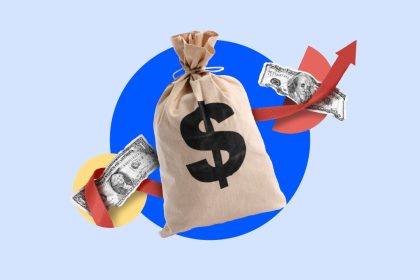Key takeaways
- You may be eligible to get a bad credit personal loan with a score below 580.
-
Personal loan lenders specializing in bad credit loans may scrutinize your income and employment history more closely.
- Bad credit personal loans usually come with higher APRs and shorter terms, so you’ll need to qualify for a higher payment.
Getting a personal loan with bad credit may require you to take extra steps to prove you can repay the loan. Lenders consider a low credit score a sign that you’ve had trouble managing credit in the past, and they usually offset that risk by charging higher APRs, fees and offering lower loan amounts that must be paid off faster than fair or good credit loans.
Knowing what you need for approval and then shopping around and comparing offers is the best way to get a personal loan if you have a low credit score.
How to get a loan with bad credit
Most lenders consider a bad credit score anything below 580. However, others may set their bad credit minimum below 670, so make sure you check the lender’s requirements. Whether consolidating high-interest rate credit cards or funding an emergency, knowing what you need to get a personal loan will help you prepare for the process.
1. Check your credit score and credit reports
Your credit score is the most important factor in the personal loan rate you’ll be offered. Personal loan rates typically range between 6 and 36 percent. The lower your score, the more likely you’ll be offered a rate of 30 percent or higher.
If you haven’t checked your scores lately, check with your credit card company or bank — they may offer a free look at one or all three of your credit scores. If they’re lower than expected, visit AnnualCreditReport.com to request your free credit reports. Federal law entitles you to a free copy of your credit report every 12 months from the major credit-reporting bureaus: Equifax, Experian and TransUnion.
Check your report for errors or old debt dragging your score down, and work to get them corrected before you apply for a personal loan.
2. Consider your income and other debts
Bad credit lenders pay extra attention to whether you have enough stable income to make payments on a new personal loan. They’ll measure the percentage of your monthly income used to pay debts. In lender terms, this is called your debt-to-income (DTI) ratio, and the maximum varies from lender to lender.
A word of warning: If the lender advertises approval for DTI ratios up to 50 percent, read the fine print. That maximum may only apply to borrowers with higher credit scores, which means you’ll be limited to a lower DTI ratio based on your score. Alternatively, the lender may offer you a lower loan amount if your DTI ratio is above its limit when you apply.
To be approved with bad credit, you’ll likely need to verify you make consistent income from a salaried or full-time hourly job. Variable income from self-employment, commissions or tips may not be acceptable to a bad credit lender.
3. Calculate monthly payment options
The monthly payment on a bad credit personal loan may be much higher than expected, especially if you’re used to making minimum payments on your credit cards. Use a personal loan calculator to see whether the monthly payment fits your budget.
Ensure you input the highest interest rate possible to get a realistic idea of what you could be paying — the calculator may be pre-filled with a lower rate than you’ll qualify for. Choose a term between three and five years, even if the lender advertises seven-year repayment options. Longer terms are generally reserved for higher credit borrowers.
4. Compare bad credit lenders
The terms for bad credit lenders may vary widely between lenders, and you should apply to no less than three different lenders and compare their rates and fees. If you have a relationship with a community bank or credit union, see if they offer any rate discounts or fee reductions for bad credit personal loans.
Online personal loan lenders may offer the most options for bad credit borrowers. Some companies use more lenient criteria than traditional banks for approval, such as your job and education history. When you’re comparing lenders, check their website or ask them for information about:
- Minimum credit scores. The minimum may be as low as 500 or as high as 670, depending on the lender.
- Loan amount ranges. Some lenders offer competitive options for smaller loan amounts (below $2,500). While several personal loan lenders offer loan amounts as high as $100,000, bad credit lenders tend to limit you to $50,000 or less.
- Repayment terms. Bad credit loan terms usually range between one and five years. Choose a longer term for the lowest possible payment. You’ll probably be capped at five years, although some lenders may offer a longer term for a smaller loan amount.
5. Get prequalified
Prequalifying allows you to see your eligibility odds and predicted rates without impacting your credit score. It’s a free tool offered by most lenders and can give you an idea of what a competitive rate could look like for you. Prequalify with at least three lenders once you finish your lender comparison shopping.
This process should only involve a soft credit pull, which doesn’t affect your credit scores.
6. Add a co-signer or co-borrower if necessary
If you can’t get prequalified for the amount you need, check to see if the lender allows you to add a co-signer or co-borrower to boost your loan amount. A co-signer is usually a creditworthy friend or family member who agrees to take equal responsibility for the loan but doesn’t have access to the funds.
A co-borrower is the same as a co-signer, except they have access to the funds you borrow. Be careful when making the decision to add someone else to your loan request. They’ll be on the hook for the loan if you can’t repay it, and their credit will be dinged if you miss a payment.
Before signing on the dotted line, make a repayment plan with your co-signer and practice clear communication when making the payments.
7. Gather financial documents
In general, personal loans only require a few financial documents for approval. However, you may need to provide extra paperwork to get approved for a personal loan with bad credit. This may include prior years’ W-2s, tax returns, and bank statements showing where your paychecks are deposited.
You may need to provide some or all of the following when you apply:
- Personal contact info, including Social Security number, full name and address.
- Your driver’s license or another form of government-issued personal identification.
- Personal loan details, like why you need the loan, how much you need and how long of a term you want.
- W-2 forms from the last two years.
- Your federal tax return from the last two years.
- Two most recent bank statements for all bank accounts.
- Recent pay stubs.
- Utility bills or mortgage statements (to verify your address).
Provide any extra requests quickly to keep the loan process moving along smoothly. Ensure the documents are legible before you send them — lenders will reject anything that’s blurry or hard to read.
8. Be prepared for a hard credit check
When you choose the lender you want to borrow from, you’ll officially apply for a personal loan. The lender will perform a hard credit check called a hard pull. A hard pull will knock down your credit score a few points in the short term.
A few months of on-time payments can offset the light hit to your score caused by a hard check. However, too many hard checks in a short time can cause longer-term damage to your credit report. Lenders can interpret this as a potential risk, as it may look like you’re applying for multiple loans or products you can’t afford.
If you need to undergo multiple hard credit inquiries, do so within 45 days to minimize credit damage. According to the latest FICO scoring model, if you apply for the same type of product multiple times within the 45-day period, then multiple hard checks will register as one inquiry on your credit report.
9. Get your bad credit personal loan funds
Once you’ve provided your paperwork, the lender can fund your loan within a business day. Funds are generally directly deposited into your bank account. If you choose a debt consolidation loan, some lenders may give you the option of paying your creditors off directly.
Most lenders offer an autopay option that withdraws your monthly payment from your bank account on the due date. An added bonus: You may be offered a lower rate or reduced fees for setting up an automatic payment.
What to consider before getting a loan with bad credit
A personal loan for bad credit may be a great tool to simplify your finances and improve your credit scores over time. That said, you should weigh the drawbacks of adding a fixed monthly payment to your budget before you make a final decision.
You’ll pay higher interest rates
The unfortunate reality of applying for a loan with a low credit score is that you’ll pay more in interest than you would with a higher credit score. However, the rates may be lower than you pay on maxed-out credit cards. Most bad credit loans are used to pay off credit card balances, which can positively impact your credit scores.
That’s because paying off revolving credit card debt directly affects your credit utilization ratio, which measures how much of your available credit you’re using. You could see a significant increase in your credit scores, which could allow you to replace a bad credit loan at a high rate with a good credit loan rate.
Loan costs are more expensive
You may pay bad credit loan fees as high as 10 percent of your loan amount. These fees come from your loan funds, meaning you have less cash for debt consolidation, home improvement or emergency costs.
Watch out for predatory lenders that ask you to pay upfront fees for approval. All fees should be deducted from your loan proceeds. You should run, not walk away from a company that pressures you to pay advance fees for any bad credit loan.
Your loan amount may be lower
Lenders that offer personal loans for bad credit borrowers usually limit you to a $50,000 loan amount. The amount may be significantly lower if you have very low credit scores (below 580) or a high DTI ratio.
Terms are generally shorter
In a lender’s eyes, a low credit score tells a lender you may have had difficulty managing your credit in the past. As a result, they may want you to commit to paying your loan of three to five years versus the six or seven years they may offer a good or excellent credit borrower.
The good news is if your credit score improves over time, you can refinance to a longer-term personal loan in the future and use the savings to pay your loan balance off faster.
Where you can get legit bad credit loans
Personal loans are available at banks, online lenders and credit unions. You can also try online marketplace lenders to have others compete for your business. Read personal loan lender reviews about the company and check online ratings to see what other customers say about their bad credit loans.
Avoid these predatory bad credit loans
Borrowers with bad credit are most likely to be targeted by predatory lenders offering payday or auto title loans. They often advertise these as no-credit check loans, which means your credit isn’t pulled for approval. The loan funds are usually available within one business day of approval with very little paperwork required.
However, they often have to be paid off very quickly with APRs that can be as high as 650 percent, leading many borrowers to take on more debt than they can repay. If possible, avoid payday loans, auto title loans or no-credit-check installment loans.
Payday loans
All you need is proof of a regular paycheck to qualify for a payday loan of up to $500. The catch is the balance — plus lender fees, which range from $10 to $30 for every $100 you borrow — must be paid back from your next paycheck.
Consumers often use these for basic needs like rent, food or utility bills. The quick repayment schedule leaves little room for the unexpected, and payday borrowers often extend or renew payday loans multiple times. Many states ban or severely restrict payday lending because of the damage it does to borrowers living paycheck to paycheck.
No-credit-check installment loans
Borrowers who need higher loan amounts than payday lenders offer may choose this type of loan to receive all of their funds at once. You’ll typically have several months to several years to pay this type of loan off, but interest rates can still run into the triple digits, making them a costly loan type.
Auto title loans
If you have a car without a lien, an auto title loan allows you to borrow against the equity using your car for collateral. The average APR for this type of loan is about 300 percent. If you default, an auto title lender can repossess your car and sell it to recoup the amount you borrowed.
Alternatives to bad credit personal loans
There are a number of alternatives to choose from if a bad credit personal loan isn’t the right fit for you.
Read the full article here
 Trending:
Trending:















